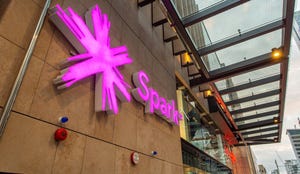Automation Focus Shifts From Cost to Customer
Faced with new Internet and cost challenges, operators are increasingly presenting automation as a means of improving the customer experience.

MADRID -- Zero Touch Automation Congress 2019 -- "I can't say zero touch because it implies laying off many people," said Telstra's Johanne Mayer at a conference that has taken one of the industry's most in-vogue expressions for its very name. It also suggests automation -- the industry trend it supposedly describes -- is all about cost savings, she might have added. That viewpoint is now meeting greater resistance from telecom executives.
"We are not discussing what efficiency we can get or how we can reduce capex and opex, but how we can offer customers a real digital experience," said Enrique Blanco, the chief technology officer of Telefónica, in summing up the Spanish operator's automation strategy during a keynote presentation at today's event. "This is key."
Recent survey results show Blanco is not alone. "Customer experience enhancement" emerged as the top priority for service providers during a recent survey by IHS Markit, which asked companies accounting for about 45% of global capex what they saw as the main drivers of digital transformation. Capex savings ranked low on the list.
But if "zero touch" is a dirty expression to some, the cost-savings and "efficiency" arguments for automation are not hard to fathom. Future 5G and "edge" networks will be far too complex for humans to manage in real time, according to Cliff Grossner, a senior research director at IHS Markit. The implication is that technology will take over, and the web giants have already shown what is possible with extreme automation and a software-based model. "One time I visited an OTT in China and they said they had only one engineer for one data center," said Huawei's Deng Fui, during the same panel discussion that featured Telstra's Mayer. "We have armies for the telco cloud."
How automation could improve customer service has been less obvious, but it was the focus of discussions here in Madrid. Today, Telstra takes between 18 and 24 months to deliver a new service to an enterprise customer, according to Mayer. Through automation, she hopes to cut that to between four and six months. The big network changes that make this possible will be simplification of Telstra's back-office systems and the adoption of standard interfaces, allowing Telstra to expose APIs to its customers more easily. "The fact the architecture is leveraging standard interfaces should let customers come in and benefit from services," she said.
Peter Konings, Verizon's enterprise products director, welcomes the new focus on what automation can do for clients. The effort to reduce costs, he tells Light Reading, has not been the most positive goal for the industry. Much like Mayer, he touts a platform-as-a-service business model -- facilitated by automation -- that could underpin a new and improved customer experience.
The shift in business priorities is not altogether surprising after a similar thing happened with virtualization. Operators that originally saw NFV as a cost-saving technology, and were disappointed on that front, have subsequently said its main benefits are in areas including service development and time to market. As operators struggle to reduce costs, and face an even bigger threat from aggressive web giants, automation is likely to follow the same path.
You're invited to attend Light Reading’s Big 5G Event! Formerly the Big Communications Event and 5G North America, Big 5G is where telecom's brightest minds deliver the critical insight needed to piece together the 5G puzzle. We'll see you May 6-8 in Denver -- communications service providers get in free!
On the cost side, a big problem -- as Grossner points out -- is the complexity that comes with virtualization, 5G and the edge. With automation, an operator might be able to avoid a profit-busting increase in headcount. And if 5G creates new service opportunities, that could even lead to fatter margins. But the challenge of introducing new software-based technologies, while maintaining legacy systems, may hinder attempts to operate with a smaller workforce.
"We started with one technology and added another and then NFV came along and helped us add more spaghetti lines," said an exasperated Mayer. "It was supposed to make things easier and cheaper because it would build on white boxes, but in terms of management it is more spaghetti lines and that makes it hard to deliver anything fast."
Legacy will also make it hard for any service provider to imitate the Chinese OTT player that Huawei's Deng admired. "We are a more complicated use case," he said, comparing the telecom industry with the web giants. "For automation, we have to find our own solutions. We can't just use their tools for the 5G core -- that is impossible."
And automation can only go so far. "Parts of the legacy we will not automate," said Telefónica's Juan Carlos Garcia when asked during a panel session how operators would tackle the old systems that still gobble up spending. "It is clearly a declining technology and you must be rational. It is not worth investing because automation requires a level of effort in systems." But like aging workaholics, these legacy systems are unlikely to be retired quickly.
In the meantime, using automation to enhance service offerings will bring all sorts of new challenges. Verizon's enterprise customers, for instance, are now turning to "consumer-type broadband" services with characteristics the operator has not even thought about in a lab environment, says Konings. "Once you let loose these services in the wild all sorts of things start happening," he said. "Enterprise customers are sometimes way ahead in terms of requirements than we are ready to deliver." The rollout of white boxes has led to similar complications. "We might get asked to activate a WiFi feature that we haven't operationalized yet."
But unless operators can realize service improvements through automation, they risk ceding even more ground to the likes of Amazon and Google. "5G is really going to challenge us and unless we convert ourselves through automation we will lose that line of sight to customers," said Mayer. "We have to insert ourselves somewhere."
Related posts:
— Iain Morris, International Editor, Light Reading
Read more about:
EuropeAbout the Author(s)
You May Also Like












